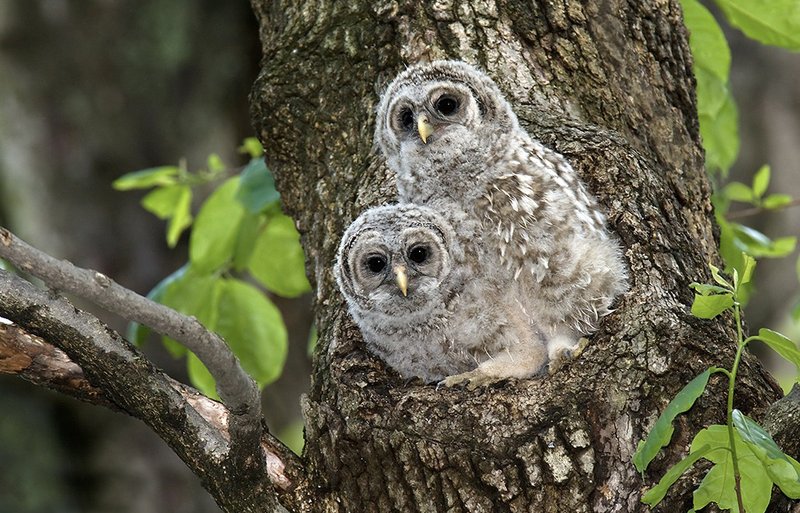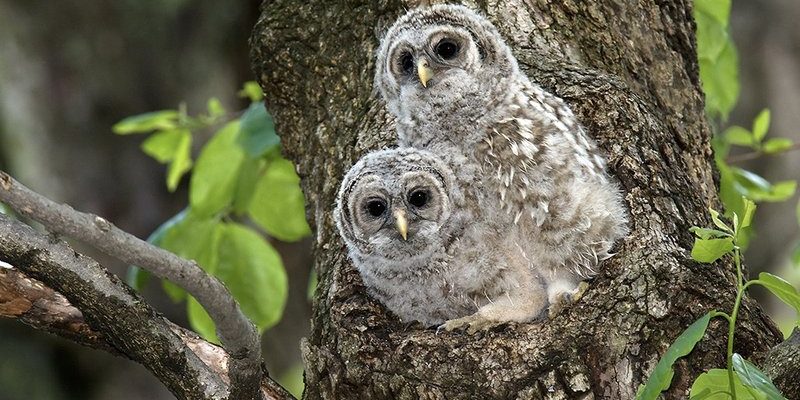
Barred owls are not just passive observers; they’re deeply involved in their habitats, showcasing unique behaviors when it comes to nesting and raising their young. So grab a warm cup of coffee, settle in, and let’s explore what makes these owls tick—from their nesting sites to their early life stages. You might be wondering, why should we care about their nesting habits? Understanding these birds helps us appreciate the delicate balance of nature and the roles each species plays in the ecosystem.
Where Do Barred Owls Nest?
Barred owls are quite adaptable when it comes to choosing a nesting site. They prefer old-growth forests that offer plenty of trees for roosting. Specifically, they often look for large, mature trees with cavities or hollows. It’s a bit like finding the perfect apartment—location matters! These cavities not only provide shelter but also a sense of safety for their eggs and chicks.
Another common nesting option for barred owls is abandoned nests of other large birds, such as hawks or crows. They’re resourceful like that! Instead of building a nest from scratch, they’ll move into a ready-made home, which saves them energy. This adaptability speaks to their resilience as a species. You might find them in forests, swamps, or even suburban areas, as long as they have access to their preferred habitat and food sources.
Peak Nesting Season
If you’re hoping to spot a barred owl during the nesting season, plan your visits from late winter to early spring. This is when these owls typically mate and lay their eggs. They tend to nest later than some other bird species, which gives their chicks a better chance of survival as they’ll hatch right when food resources become more abundant. Timing is everything, right?
During this period, females will lay anywhere from two to four eggs, and both parents take part in caring for the young. The male often brings food, while the female incubates the eggs. It’s a true team effort! After about 28 to 33 days, those eggs will hatch, and the little owlets will begin their journey into the world.
A Closer Look at the Barred Owl Lifecycle
The lifecycle of a barred owl is a remarkable journey. Once the eggs hatch, the owlets are born altricial, meaning they’re quite helpless at first. Their eyes are closed, and they rely entirely on their parents for food and warmth. It’s like being a newborn human—totally dependent! The parents work tirelessly, bringing small mammals, birds, and insects to feed their growing chicks.
During the first few weeks, the owlets will stay in the nest, growing rapidly. After about three weeks, they’ll start to develop feathers and get a bit adventurous. You might even see them peeking out of the nest, curious about the big world outside. They’re like kids on a playground, ready to explore but still needing a watchful eye.
Learning to Fly
By the time they reach six weeks old, it’s almost time for the owlets to take flight. They’ll start hopping around the nest and practicing their wing flaps, excited about their newfound freedom. You can imagine their little hearts racing as they prepare to soar into the sky! By around ten weeks, they typically take their first flights.
But here’s the thing: just because they can fly doesn’t mean they’re fully independent. They still rely on their parents for food during this transition period. They’re learning the ropes of survival—where to find food, how to hunt, and what it means to be a barred owl in the wild.
What Do Barred Owls Eat?
Understanding what barred owls eat gives us greater insight into their role in the ecosystem. These birds are primarily nocturnal hunters, and they have a varied diet. Small mammals like *mice, voles*, and *rabbits* make up a significant portion of their meals. They will also eat birds, reptiles, and even amphibians if the opportunity presents itself.
Barred owls have excellent hearing and vision at night, which makes them efficient hunters after dusk. Think of them as the ultimate night-time predators, sneaking through the trees with stealth and precision. They can even detect sounds from underground, honing in on prey without ever seeing them. This skill is crucial for their survival, especially when they’re feeding their chicks.
Impact of Diet on Nesting Success
A varied diet plays a vital role in the success of their nesting. If food is abundant, the parents can provide ample nutrition for their growing owlets, leading to stronger, healthier chicks. Conversely, during years when prey is scarce, fewer chicks may survive. This fluctuation highlights the complexities of nature—how food availability can directly impact the next generation of barred owls.
Moreover, environmental factors can also affect their food sources. Habitat destruction, climate change, and human encroachment on their territories can all lead to food shortages. This relationship between diet and nesting success is crucial for conservation efforts aimed at protecting these majestic birds.
Challenges Barred Owls Face
Like many wildlife species, barred owls face several challenges. Habitat loss is one of the main threats they encounter. As forests are cut down for urban development or agriculture, these birds lose their homes and nesting sites. It’s akin to being forced out of a beloved neighborhood—you just might not thrive as well elsewhere.
Another significant challenge is competition with other species. In areas where barred owls reside, they often compete with *great horned owls*, which are larger and more aggressive. This competition can affect their ability to find food and secure nesting sites. Let’s not forget about human impacts either. Road accidents, hunting, and even poisoning from rodenticides can take a toll on their populations.
Conservation Efforts for Barred Owls
Thankfully, various organizations are working to conserve barred owls and their habitats. By protecting forests and creating reserves, we can ensure these stunning birds continue to thrive. Many wildlife enthusiasts participate in local conservation efforts, from habitat restoration projects to educational campaigns aimed at raising awareness about the importance of protecting them and their environments.
Engaging with local wildlife groups is a great way to get involved. You might be surprised by how many back-to-nature initiatives are happening right in your community! Even small actions, like spreading awareness or supporting conservation funds, can make a significant difference.
Barred owls are more than just beautiful birds; they’re essential members of our ecosystems. Learning about their nesting habits and lifecycle not only deepens our appreciation for them, but it also highlights the importance of protecting their habitats. As you go about your day, take a moment to listen for their hoots or look for them perched on a tree branch.
Next time you encounter a barred owl in the wild, remember the journey they’ve taken—from vulnerable chicks to wise, efficient hunters. Every step of their lifecycle is a testament to resilience and adaptability. So, let’s cherish these remarkable creatures and do our part to ensure they continue to thrive for generations to come.

